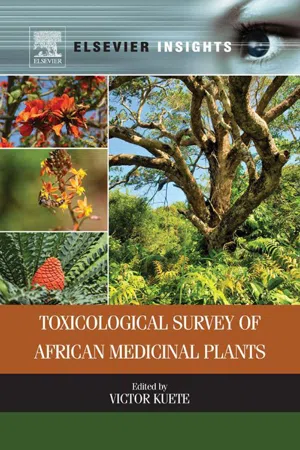
- 744 pages
- English
- ePUB (mobile friendly)
- Available on iOS & Android
Toxicological Survey of African Medicinal Plants
About This Book
Toxicological Survey of African Medicinal Plants provides a detailed overview of toxicological studies relating to traditionally used medicinal plants in Africa, with special emphasis on the methodologies and tools used for data collection and interpretation. The book considers the physical parameters of these plants and their effect upon various areas of the body and human health, including chapters dedicated to genotoxicity, hepatotoxicity, nephrotoxicity, cardiotoxicity, neurotoxicity, and specific organs and systems.Following this discussion of the effects of medicinal plants is a critical review of the guidelines and methods in use for toxicological research as well as the state of toxicology studies in Africa. With up-to-date research provided by a team of experts, Toxicological Survey of African Medicinal Plants is an invaluable resource for researchers and students involved in pharmacology, toxicology, phytochemistry, medicine, pharmacognosy, and pharmaceutical biology.
- Offers a critical review of the methods used in toxicological survey of medicinal plants
- Provides up-to-date toxicological data on African medicinal plants and families
- Serves as a resource tool for students and scientists in the various areas of toxicology
Frequently asked questions
Information
Toxicological Societies in Africa
Roles and Impact in Policy Making and Living Conditions
Keywords
1.1 Introduction
1.2 Toxicological Societies in Africa
1.2.1 African Society for Toxicological Sciences
1.2.1.1 Mission
1.2.1.2 Goals
1.2.1.3 History and Achievements of ASTS
1.2.2 Society of Environmental Toxicology and Chemistry
1.2.2.1 Goals of SETAC Africa
Table of contents
- Cover image
- Title page
- Table of Contents
- Copyright
- Preface
- List of Contributors
- 1. Toxicological Societies in Africa: Roles and Impact in Policy Making and Living Conditions
- 2. Ethical Issues for Animal Use in Toxicological Research in Africa
- 3. Critical Review of the Guidelines and Methods in Toxicological Research in Africa
- 4. Discordant Results in Plant Toxicity Studies in Africa: Attempt of Standardization
- 5. Acute and Subacute Toxicities of African Medicinal Plants
- 6. Subchronic and Chronic Toxicities of African Medicinal Plants
- 7. Toxic Plants Used in African Traditional Medicine
- 8. Cytotoxicity of African Medicinal Plants Against Normal Animal and Human Cells
- 9. Genotoxicity and Teratogenicity of African Medicinal Plants
- 10. Mutagenicity and Carcinogenicity of African Medicinal Plants
- 11. Hepatotoxicity and Hepatoprotective Effects of African Medicinal Plants
- 12. Nephrotoxicity and Nephroprotective Potential of African Medicinal Plants
- 13. Cardiotoxicity and Cardioprotective Effects of African Medicinal Plants
- 14. Neurotoxicity and Neuroprotective Effects of African Medicinal Plants
- 15. Toxicity and Beneficial Effects of Some African Plants on the Reproductive System
- 16. African Plants with Dermatological and Ocular Relevance
- 17. Toxicity and Protective Effects of African Medicinal Plants on the Spleen and Lung
- 18. Safe African Medicinal Plants for Clinical Studies
- 19. Harmful and Protective Effects of Terpenoids from African Medicinal Plants
- 20. Harmful and Protective Effects of Phenolic Compounds from African Medicinal Plants
- 21. Health Effects of Alkaloids from African Medicinal Plants
- 22. Physical, Hematological, and Histopathological Signs of Toxicity Induced by African Medicinal Plants
- 23. Biochemical Parameters in Toxicological Studies in Africa: Significance, Principle of Methods, Data Interpretation, and Use in Plant Screenings